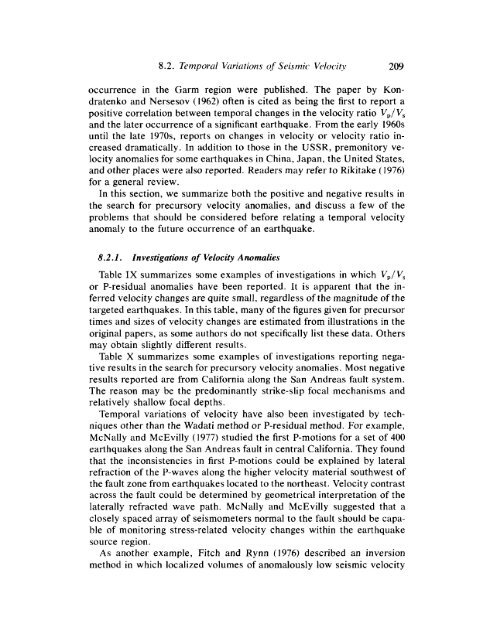principles and applications of microearthquake networks
principles and applications of microearthquake networks
principles and applications of microearthquake networks
You also want an ePaper? Increase the reach of your titles
YUMPU automatically turns print PDFs into web optimized ePapers that Google loves.
8.2. Temporal V'iricrtions <strong>of</strong> Seismic. Velocity 209<br />
occurrence in the Garm region were published. The paper by Kondratenko<br />
<strong>and</strong> Nersesov (1962) <strong>of</strong>ten is cited as being the first to report a<br />
positive correlation between temporal changes in the velocity ratio V,/V,<br />
<strong>and</strong> the later occurrence <strong>of</strong> a significant earthquake. From the early 1960s<br />
until the late 1970s, reports on changes in velocity or velocity ratio increased<br />
dramatically. In addition to those in the USSR, premonitory velocity<br />
anomalies for some earthquakes in China, Japan, the United States,<br />
<strong>and</strong> other places were also reported. Readers may refer to Rikitake (1976)<br />
for a general review.<br />
In this section, we summarize both the positive <strong>and</strong> negative results in<br />
the search for precursory velocity anomalies, <strong>and</strong> discuss a few <strong>of</strong> the<br />
problems that should be considered before relating a temporal velocity<br />
anomaly to the future occurrence <strong>of</strong> an earthquake.<br />
8.2.1. Investigations <strong>of</strong> Velocity Anomalies<br />
Table IX summarizes some examples <strong>of</strong> investigations in which V,/V,<br />
or P-residual anomalies have been reported. It is apparent that the inferred<br />
velocity changes are quite small, regardless <strong>of</strong> the magnitude <strong>of</strong> the<br />
targeted earthquakes. In this table, many <strong>of</strong> the figures given for precursor<br />
times <strong>and</strong> sizes <strong>of</strong> velocity changes are estimated from illustrations in the<br />
original papers, as some authors do not specifically list these data. Others<br />
may obtain slightly different results.<br />
Table X summarizes some examples <strong>of</strong> investigations reporting negative<br />
results in the search for precursory velocity anomalies. Most negative<br />
results reported are from California along the San Andreas fault system.<br />
The reason may be the predominantly strike-slip focal mechanisms <strong>and</strong><br />
relatively shallow focal depths.<br />
Temporal variations <strong>of</strong> velocity have also been investigated by techniques<br />
other than the Wadati method or P-residual method. For example,<br />
McNally <strong>and</strong> McEvilly (1977) studied the first P-motions for a set <strong>of</strong> 400<br />
earthquakes along the San Andreas fault in central California. They found<br />
that the inconsistencies in first P-motions could be explained by lateral<br />
refraction <strong>of</strong> the P-waves along the higher velocity material southwest <strong>of</strong><br />
the fault zone from earthquakes located to the northeast. Velocity contrast<br />
across the fault could be determined by geometrical interpretation <strong>of</strong> the<br />
laterally refracted wave path. McNally <strong>and</strong> McEvilly suggested that a<br />
closely spaced array <strong>of</strong> seismometers normal to the fault should be capable<br />
<strong>of</strong> monitoring stress-related velocity changes within the earthquake<br />
source region.<br />
As another example, Fitch <strong>and</strong> Rynn (1976) described an inversion<br />
method in which localized volumes <strong>of</strong> anomalously low seismic velocity






